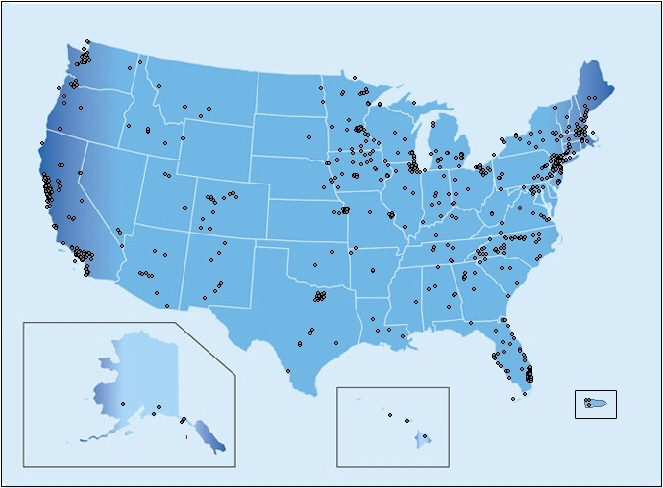 Climate change is clearly an important issue, and there is a lot that needs to be done about it at all levels of society. Fortunately there have been individuals and localities that have made great efforts to reduce their carbon footprint, and this should be applauded. I want to focus on a particular success in the area of local effort to reduce emissions and improve efficiency: The Mayor’s Climate Protection Agreement. This is an agreement between the mayors of several hundred participating cities, across the U.S to reduce their emissions to 7% below 1990 levels.
Climate change is clearly an important issue, and there is a lot that needs to be done about it at all levels of society. Fortunately there have been individuals and localities that have made great efforts to reduce their carbon footprint, and this should be applauded. I want to focus on a particular success in the area of local effort to reduce emissions and improve efficiency: The Mayor’s Climate Protection Agreement. This is an agreement between the mayors of several hundred participating cities, across the U.S to reduce their emissions to 7% below 1990 levels.
![]() The agreement was started on February 16, 2005 by Seattle Mayor Greg Nickels and there are currently 944 participating cities in the United States that have pledged to reduce their emissions below 1990 levels. The agreement was officially endorsed by the Annual U.S Conference of Mayors in 2005, and the conference has actively encouraged Mayors to sign onto the agreement since. Mayors in participating towns and cities use practices such as vegetation restoration, anti-sprawl policies, emissions controls and efficiency improvement activities to improve their climate friendliness.
The agreement was started on February 16, 2005 by Seattle Mayor Greg Nickels and there are currently 944 participating cities in the United States that have pledged to reduce their emissions below 1990 levels. The agreement was officially endorsed by the Annual U.S Conference of Mayors in 2005, and the conference has actively encouraged Mayors to sign onto the agreement since. Mayors in participating towns and cities use practices such as vegetation restoration, anti-sprawl policies, emissions controls and efficiency improvement activities to improve their climate friendliness.
Many of the cities involved have a large commuter culture and many of these have made an effort to improve public transportation to cut down on auto emissions. Seattle is an excellent example of this. They have made huge investments in a street car system that will transfer passengers from downtown to South Lake Union, as well as monorail and light rail network that is expected to be functioning within the next five years.
Other cities have made use of CACP (Clean Air and Climate Protection) software. This software developed by the Local Governments for Sustainability allows local governments to enter basic information and calculate their cities carbon footprint and analyze the effects of different efficiency and emissions reduction measures. It can be used in conjunction with the EPA’s Energy Star Portfolio Manager to track energy use month by month and create an integrated plan to cut emissions and improve efficiency.
Other cities have taken further measures to insure that their buildings meet LEED (Leadership in Energy and Environmental Design) certification requirements, which is a set of strict specifications devised by the U.S Green Buildings Coalition. Buildings meeting these certifications use energy more effectively and provide cleaner living and work environments than other buildings. These buildings have high standards for water and energy use and often are well insulated and use alternative energy sources for heating and cooling.
I recently had the opportunity to speak with Mayor Ben White, of College Station, a participating Texas City, and his staff. Mr. White detailed the efforts the city had gone through to make to make all of its public buildings more efficient, as well as its sewage system. He also stated that they were in the process of gradually replacing the city’s fleet of vehicles with hybrids and other low emitters. Additionally, he expressed interest in adding wind power to the grid, which could be provided by some proposed wind farms near the Brazos valley. During this meeting I also found out that College Station is in the process of switching its public computers to Windows Vista, which has multiple energy saving features built into it and can save a user over $70 in electricity per year. He had also attended the 2008 Annual Mayors conference and was happy to point out that the primary focus that year was finding ways to make cities more environmentally friendly. In fact, the conference now presents awards to mayors who have done an outstanding job reducing emissions in their cities.
It should be noted that the agreement is honor system based, and for many of the cities involved there is no accurate way of determining what there emission levels were in 1991. However, the voluntary willingness to act on these issues by city governments is very pleasing to see. It is also pleasing to see that these measures have been generally supported by the populations of the cities involved (though Mayor White says he has heard some accusations of “Gore-munism”). It shows how important voluntary local action can be in making changes that have stalled on the national level.
Over 70 million Americans live in cities that have signed onto the agreement, and changes in behavior in these major population centers are crucial to fighting climate change. Fighting climate change will require massive changes to take place at the local level — so what better place for it to start?


